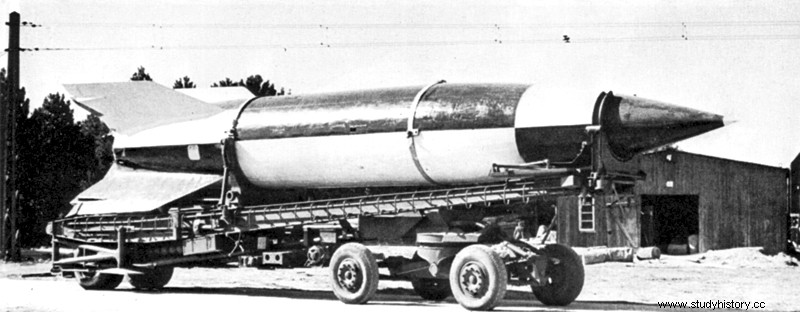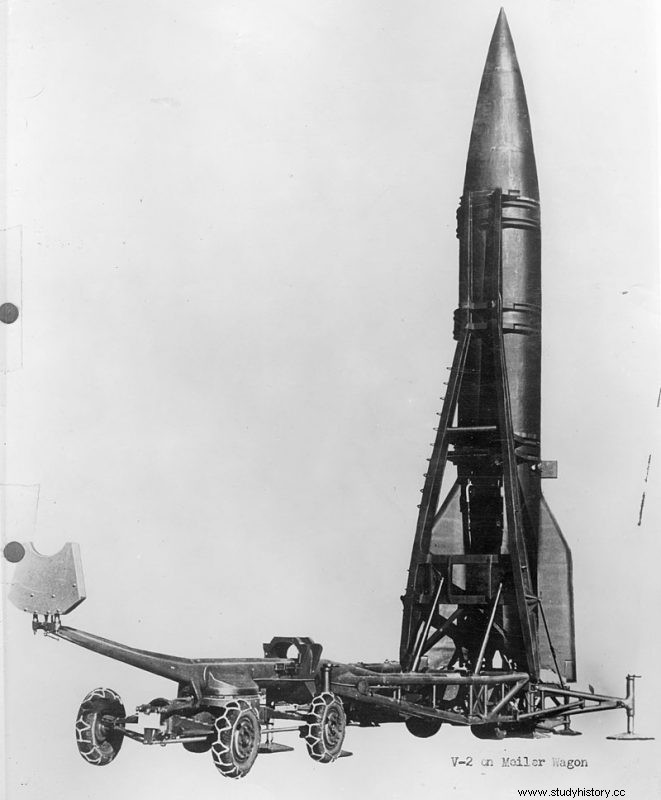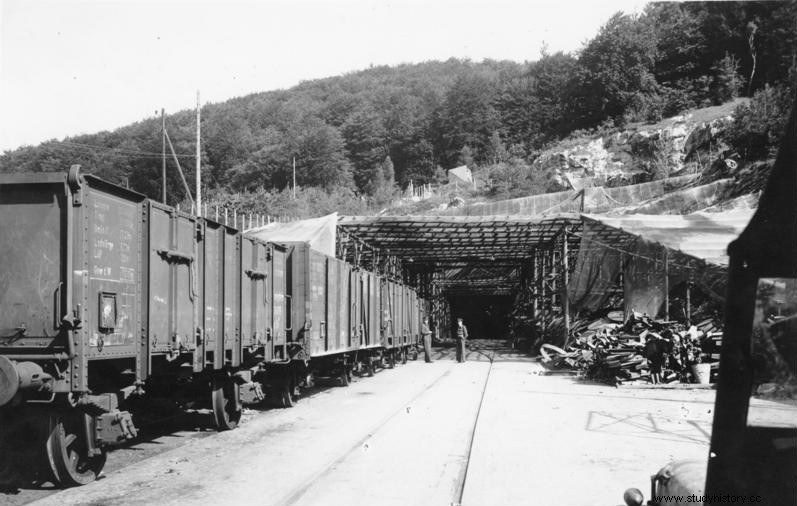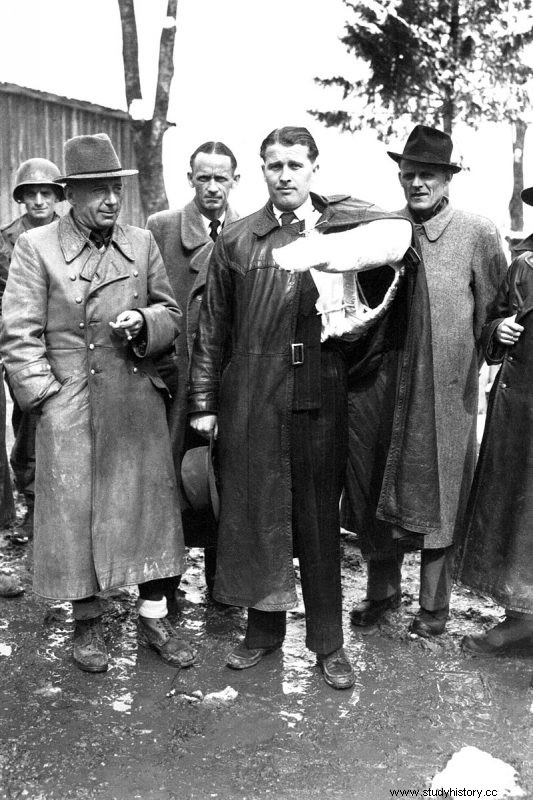By September 1944, Western Allied troops had succeeded in liberating most of France. Nazi Germany troops were in retreat. Control of the skies was assured by the RAF and the USAF. The air raids on Great Britain had ceased. It seemed that the war would not last long and above all, that the Nazi troops were defeated and unable to react. On September 8, 1944, however, the first V2 will fall on London. The impact destroys part of the buildings on Staveley Road, in the London neighborhood of Chiswik. That same day another V2 is launched against Paris, impacting near the Porte d'Italie. They would be the first two rockets of more than 3000.

At first, Londoners think that it is just another V1, one of the many that the Nazis had already launched that summer. The V1 had a limited explosive charge and being propelled by a rocket engine, the sound warned of their arrival. Before impact, the engine was turned off, so it was possible to calculate how long it would take to impact after engine shutdown.
V2 would be different. There would be no way to prevent attacks from the first operational ballistic missile in history. When the V2 went down, and it did so at supersonic speed, carrying a one ton warhead, it could destroy an entire neighborhood. The noise when breaking the sound barrier and the explosion were nothing compared to that of the V1. It was something completely new.
The development of V-weapons
In 1944, Wernher von Braun is 32 years old. He is the chief engineer of the Peenemünde facility, Nazi Germany's secret technological development facility. Located on the north coast of Germany, the place had different laboratories and testing fields to develop all kinds of revolutionary weapons. It will be here where V2 will be developed.
The Versailles Treaty had greatly limited Germany's weapons development. The country was prohibited from developing and manufacturing large warships, tanks, aircraft, and heavy artillery. However, the development of rockets was not contemplated. Although rockets had been used as artillery in ancient times in medieval and Napoleonic wars, their use had disappeared from the battlefield by 1919. During the 1920s private rocket development clubs began to appear throughout Germany. They were basically little models that hobbyists tried to blow up, but for von Braun this will be his first engineering school.

Von Braun joined the Nazi party in 1937. Based on the data available, it is not possible to appreciate a special interest in the politics of the German engineer, but it is known that he was a great opportunist. Membership in the party and closeness to the regime could provide him with the means to achieve his great dream, the trip to the Moon.
The V or Revenge weapons program had begun during the war. The Allies knew that Nazi Germany was developing innovative weapons, but they did not know what exactly they were. It was suspected that they would be flying bombs, but these were speculations. However, in 1943 two captured Nazi generals were overheard talking openly about rockets. The conversation could be captured thanks to the listening system that the British secret service installed in the locations where captured Nazi generals and high-ranking officers were guarded in Great Britain. The graphic confirmation would come in the spring of that same 1943, when an RAF reconnaissance photo the presence of rockets.
The information about the V2 rocket in particular came from the hand of a French spy, Jeannine Russeau. Russeau works as a translator for the Germans in France, but at the same time she collaborates with Western intelligence by transmitting the information of the conversations she listens to. Russeau managed to send vital information to the Allies about the rocket development center at Peenemünde, Nazi Germany's Cape Canaveral. Jeannine Russeau was killed by the Germans before British intelligence could get her off the continent.
Nazi Germany's rocket battle
Once the existence of the Nazi rocket program was confirmed and its resounding success could be seen first-hand, the destruction of the rockets, the Peenemünde research center and the capture of the Nazi scientists became a priority. The first step was to stop the development of these weapons and for this operation Hydra was launched. On August 17 and 18, 1943, the RAF launched a massive air attack on the Peenemünde installations, with the intention of ending the Nazi rocket program. More than 600 RAF bombers were launched against the facilities, with the aim of destroying them and killing most of the researchers. Von Braun was sleeping when the attack began. He took refuge in an anti-aircraft bunker and managed to save his life. Although the attack was massive, it missed the main objective. The Hydra operation was a failure. Production was slowed down, but nothing more.
After the British attack, the Nazi commanders learned that the program had been discovered, so they moved production to some old abandoned mines in the center of the country. The facilities would receive the name of Mittelwerk. At its peak production, the Mittelwerk factory produced up to 700 V2s in a month.

By the end of 1944 the Allies know that Nazi Germany does not have much left. However, Hitler considers that he still has a chance of winning the war. On the one hand, the Ardennes Offensive is being prepared for that Christmas. Within the plan of attack, the key von Braunson bombs. During the previous months thousands of them have fallen in the cities of Western Europe. The most punished city will be Antwerp, with more than 1,000 shells. That same Christmas, Wernher von Braun and all those responsible for the production of the V2 will receive the Knight's Cross, the highest distinction of the Third Reich from the arms minister Albert Speer.
By 1944 the United States has also set its sights on the Nazi rocket project. The United States, unlike Great Britain, prioritizes the capture of Nazi scientists rather than their elimination. They know that they are far behind technologically in certain fields, and the Americans seek to overcome this disadvantage by enlisting the support of Nazi German technicians.
The V2 rockets had no possible defense. Since they could not be located in flight or destroyed, it was necessary to find some way to neutralize them. The British MI6 developed an intelligence operation for this purpose. The DoubleCross Operation it was intended to miss targets for V2 rockets. The operation was based on arresting agents infiltrated by the Nazis in Great Britain and forcing them to pass erroneous information about the impacts of the V2 projectiles. The agents reported that the rockets missed their target and corrected the coordinates so that they were supposedly more precise. With this project, the rockets were able to hit outside of London, in places where they did not pose any danger to the population. The most important agent used in this operation was Wolf Schmidt, whose code name was Agent Tate.
The recruitment of Nazi technicians in the West
The V2 rocket attacks ended in March 1945, after the Allies had crossed the Rhine and entered the city of Cologne. With the war nearly over, the race to seize Nazi Germany's rocket technology begins. The Soviets, British and Americans will fight to catch the Nazi scientists and capture their facilities and technological documentation.

Within weeks of the end of the war, von Braun and his associates hid much of the documentation on the German rocket program in a cave near the Mittelwerk factory. That would be their currency as soon as the Soviets or Americans arrived on the scene.
Although Mittelwerk would be within the British occupation zone, before the end of the war the Americans were the first to arrive in the area and who liberated the concentration camps that fed slave labor to the place. Although the facility was found mostly intact, von Braun and his team were not there. Days earlier they had escaped to the Bavarian Alps for fear of being captured by the Soviets. There they hoped to surrender to the Americans.
Following the announcement of Hitler's death in Berlin, Nazi scientists sent von Braun's brother Magnus to seek out American troops to demand his surrender. Finally von Braun and his best scientists and engineers surrender to the US 44th Infantry Division. At Mittelwerk the United States collects all the V2 parts and machinery before the British or Soviets get there. More than 300 train cars were loaded with material extracted from the factory, but the documentation is missing. This will be found on May 27, 1945 in the same place where von Braun had hidden it a week before.
In September 1945, von Braun and several of his associates arrived in the United States. They were held in Boston for questioning. They were considered war criminals and should therefore be brought to justice. However, given the high value of these technicians, the United States launched the operation Paperclip , which whitewashed the past of these technicians and put them to work for the country in its space rocket program. Wernher von Braun was the director of the program that developed the Saturn rockets that carried man to the Moon in 1969.
